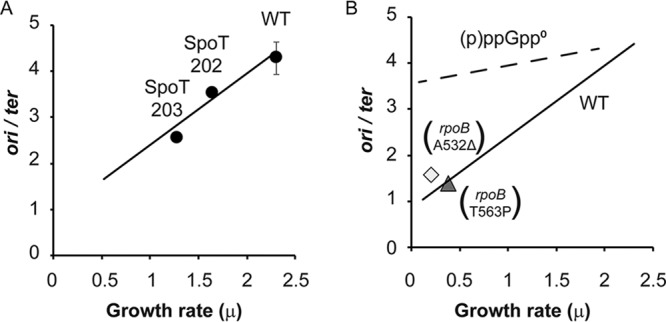FIG 3.

(p)ppGpp is sufficient to inhibit initiation of DNA replication, probably involving gene expression. (A) Strains with increased (p)ppGpp basal levels due to (p)ppGpp hydrolase defects (MG1655 [WT], CF17960 [SpoT202], and CF17961 [SpoT203]) were grown in LB, and ori/ter ratios were determined. The line shows the relation between the ori/ter ratio and the growth rate observed for the WT growing in different media (Fig. 1). A chi-square goodness-of-fit test was used to determine that the samples follow the WT pattern with a 98.1% probability. (B) Strains lacking (p)ppGpp but containing RNA polymerase phenocopy mutants that mimic the presence of (p)ppGpp. Mutant alleles rpoB-A532Δ (CF11760) and rpoB-T563P (CF11768) suppress the amino acid requirements of (p)ppGpp0 hosts and allow growth in M9 glucose minimal medium. Under these conditions, the ori/ter ratios are lowered to approximate values found for a slow-growing WT strain. The solid line reflects the relation between ori/ter ratios and growth rates for the WT strain. The dashed line reflects the relation for (p)ppGpp0 strains without rpoB mutations, varying balanced growth rates when grown in different media, as shown in Fig. 1. A chi-square goodness-of-fit test was used to determine that the samples follow the WT pattern with a 93.3% probability. Error bars represent the SD from 2 biological replicates and 3 technical replicates.
